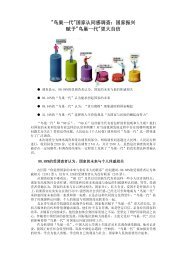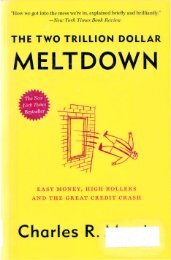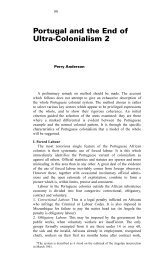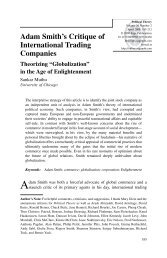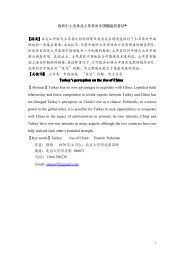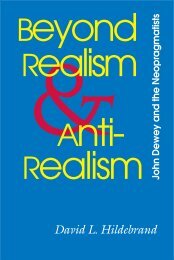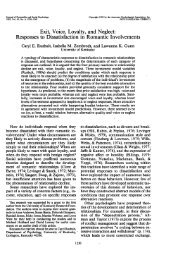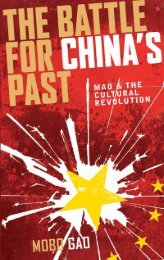- Page 2:
Chinese Economic DevelopmentThis bo
- Page 8 and 9:
ContentsList of boxesList of figure
- Page 10 and 11:
Boxes1.1 The determinants of econom
- Page 12 and 13:
Figures xi7.5 Trends in labour prod
- Page 14 and 15:
Tables1.1 Estimates of GDP per pers
- Page 16 and 17:
GlossaryAbbreviations and key conce
- Page 18 and 19:
Glossary xviiNDP gross domestic pro
- Page 20:
Glossary xixgating the excesses of
- Page 23 and 24:
xxii Introductionneeded to be trans
- Page 25 and 26:
xxiv Introductionon spatial inequal
- Page 27 and 28:
xxvi Introductioncomponents of the
- Page 30:
Part 1Starting points
- Page 33 and 34:
4 Chinese Economic Developmentfacto
- Page 35 and 36:
6 Chinese Economic Developmentin an
- Page 37 and 38:
8 Chinese Economic DevelopmentLaure
- Page 39 and 40:
10 Chinese Economic DevelopmentTabl
- Page 41 and 42:
12 Chinese Economic Developmentweig
- Page 43 and 44:
14 Chinese Economic Developmentwhic
- Page 45 and 46:
16 Chinese Economic DevelopmentIt i
- Page 47 and 48:
18 Chinese Economic Development[Jap
- Page 49 and 50:
20 Chinese Economic Developmentacti
- Page 51 and 52:
22 Chinese Economic Developmentowes
- Page 53 and 54:
24 Chinese Economic DevelopmentAs w
- Page 55 and 56:
26 Chinese Economic DevelopmentAlba
- Page 57 and 58:
28 Chinese Economic Developmentcert
- Page 59 and 60:
30 Chinese Economic Developmentcan
- Page 61 and 62:
32 Chinese Economic Developmentare
- Page 63 and 64:
34 Chinese Economic Developmentoffe
- Page 65 and 66:
36 Chinese Economic Developmentreso
- Page 67 and 68:
38 Chinese Economic Developmentwas
- Page 69 and 70:
40 Chinese Economic Developmenthad
- Page 71 and 72:
42 Chinese Economic Developmentthat
- Page 73 and 74:
2 The Chinese economy on theeve of
- Page 75 and 76:
46 Chinese Economic Developmentcomp
- Page 77 and 78:
48 Chinese Economic DevelopmentAt n
- Page 79 and 80:
50 Chinese Economic DevelopmentFor
- Page 81 and 82:
52 Chinese Economic DevelopmentRaws
- Page 83 and 84:
54 Chinese Economic DevelopmentChin
- Page 85 and 86:
56 Chinese Economic DevelopmentTabl
- Page 87 and 88:
58 Chinese Economic Developmentthe
- Page 89 and 90:
60 Chinese Economic Developmenthowe
- Page 91 and 92:
62 Chinese Economic DevelopmentThat
- Page 93 and 94:
64 Chinese Economic Developmentthe
- Page 95 and 96:
66 Chinese Economic DevelopmentTabl
- Page 97 and 98:
68 Chinese Economic Developmentothe
- Page 99 and 100:
70 Chinese Economic DevelopmentBran
- Page 101 and 102:
72 Chinese Economic Developmentend
- Page 103 and 104:
74 Chinese Economic Development5 Th
- Page 106:
Part 2The transition to socialism,1
- Page 109 and 110: 80 Chinese Economic DevelopmentThre
- Page 111 and 112: 82 Chinese Economic Developmentmost
- Page 113 and 114: 84 Chinese Economic Developmentgrea
- Page 115 and 116: 86 Chinese Economic DevelopmentOur
- Page 117 and 118: 88 Chinese Economic Developmentcons
- Page 119 and 120: 90 Chinese Economic DevelopmentTabl
- Page 121 and 122: 92 Chinese Economic DevelopmentTabl
- Page 123 and 124: 94 Chinese Economic Developmentmode
- Page 125 and 126: 96 Chinese Economic Developmentfocu
- Page 127 and 128: 98 Chinese Economic DevelopmentTabl
- Page 129 and 130: 100 Chinese Economic Developmentpro
- Page 131 and 132: 102 Chinese Economic DevelopmentTab
- Page 133 and 134: 104 Chinese Economic DevelopmentTab
- Page 135 and 136: 106 Chinese Economic Developmentpro
- Page 137 and 138: 108 Chinese Economic Developmentsup
- Page 139 and 140: 110 Chinese Economic Developmentins
- Page 141 and 142: 112 Chinese Economic DevelopmentFur
- Page 143 and 144: 114 Chinese Economic Developmentamb
- Page 145 and 146: 116 Chinese Economic DevelopmentWal
- Page 147 and 148: 4 The Great Famine, 1955-1963China
- Page 149 and 150: 120 Chinese Economic Developmentbec
- Page 151 and 152: 122 Chinese Economic DevelopmentGiv
- Page 153 and 154: 124 Chinese Economic Developmentout
- Page 155 and 156: 126 Chinese Economic DevelopmentThe
- Page 157: 128 Chinese Economic DevelopmentTab
- Page 161 and 162: 132 Chinese Economic Developmentlea
- Page 163 and 164: 134 Chinese Economic Developmentaba
- Page 165 and 166: 136 Chinese Economic Development180
- Page 167 and 168: 138 Chinese Economic Development0.9
- Page 169 and 170: 140 Chinese Economic Development3 T
- Page 172: Part 3The late Maoist era, 1963-197
- Page 175 and 176: 146 Chinese Economic DevelopmentBox
- Page 177 and 178: 148 Chinese Economic DevelopmentWhe
- Page 179 and 180: 150 Chinese Economic Developmentaro
- Page 181 and 182: 152 Chinese Economic DevelopmentThe
- Page 183 and 184: 154 Chinese Economic Developmentbut
- Page 185 and 186: 156 Chinese Economic Developmentdur
- Page 187 and 188: 158 Chinese Economic DevelopmentThe
- Page 189 and 190: 160 Chinese Economic Developmentstu
- Page 191 and 192: 162 Chinese Economic Developmentthe
- Page 193 and 194: 164 Chinese Economic Developmentclo
- Page 195 and 196: 166 Chinese Economic DevelopmentThe
- Page 197 and 198: 168 Chinese Economic DevelopmentYun
- Page 199 and 200: 170 Chinese Economic Developmentmin
- Page 201 and 202: 172 Chinese Economic Development8 H
- Page 203 and 204: 6 The revolution in educationAs we
- Page 205 and 206: 176 Chinese Economic Developmentred
- Page 207 and 208: 178 Chinese Economic DevelopmentEdu
- Page 209 and 210:
180 Chinese Economic Development195
- Page 211 and 212:
182 Chinese Economic Developmentimp
- Page 213 and 214:
184 Chinese Economic DevelopmentUng
- Page 215 and 216:
186 Chinese Economic Developmenttyp
- Page 217 and 218:
188 Chinese Economic Developmentkee
- Page 219 and 220:
190 Chinese Economic DevelopmentIt
- Page 221 and 222:
192 Chinese Economic Development100
- Page 223 and 224:
194 Chinese Economic Development100
- Page 225 and 226:
196 Chinese Economic Developmentdra
- Page 227 and 228:
198 Chinese Economic DevelopmentThe
- Page 229 and 230:
200 Chinese Economic DevelopmentGua
- Page 231 and 232:
202 Chinese Economic Developmenttho
- Page 233 and 234:
204 Chinese Economic Developmentonl
- Page 235 and 236:
206 Chinese Economic Developmenthig
- Page 237 and 238:
208 Chinese Economic Developmentmay
- Page 239 and 240:
210 Chinese Economic Developmentthe
- Page 241 and 242:
212 Chinese Economic Development15
- Page 243 and 244:
214 Chinese Economic Developmentapp
- Page 245 and 246:
216 Chinese Economic Developmentcon
- Page 247 and 248:
218 Chinese Economic Developmentawa
- Page 249 and 250:
220 Chinese Economic DevelopmentAnd
- Page 251 and 252:
222 Chinese Economic Developmenttha
- Page 253 and 254:
224 Chinese Economic DevelopmentJan
- Page 255 and 256:
226 Chinese Economic Developmentcro
- Page 257 and 258:
228 Chinese Economic DevelopmentTab
- Page 259 and 260:
230 Chinese Economic Developmentis
- Page 261 and 262:
232 Chinese Economic Development(b)
- Page 263 and 264:
234 Chinese Economic DevelopmentPar
- Page 265 and 266:
236 Chinese Economic Developmentand
- Page 267 and 268:
238 Chinese Economic DevelopmentThe
- Page 269 and 270:
240 Chinese Economic DevelopmentCol
- Page 271 and 272:
242 Chinese Economic Developmentpea
- Page 273 and 274:
244 Chinese Economic Development170
- Page 275 and 276:
246 Chinese Economic Development198
- Page 277 and 278:
248 Chinese Economic Development109
- Page 279 and 280:
250 Chinese Economic Developmentsur
- Page 281 and 282:
252 Chinese Economic Development60
- Page 283 and 284:
254 Chinese Economic DevelopmentTab
- Page 285 and 286:
256 Chinese Economic Developmentrel
- Page 287 and 288:
258 Chinese Economic Development20
- Page 289 and 290:
260 Chinese Economic Developmentif
- Page 291 and 292:
262 Chinese Economic Developmentinc
- Page 293 and 294:
264 Chinese Economic DevelopmentThe
- Page 295 and 296:
266 Chinese Economic DevelopmentThe
- Page 297 and 298:
268 Chinese Economic Developmentmou
- Page 299 and 300:
270 Chinese Economic Developmentwas
- Page 301 and 302:
272 Chinese Economic DevelopmentUnd
- Page 303 and 304:
274 Chinese Economic Developmentund
- Page 305 and 306:
276 Chinese Economic Developmentspe
- Page 307 and 308:
278 Chinese Economic DevelopmentTab
- Page 309 and 310:
280 Chinese Economic Developmentbia
- Page 311 and 312:
282 Chinese Economic DevelopmentInd
- Page 313 and 314:
284 Chinese Economic DevelopmentNot
- Page 315 and 316:
9 Late MaoismAn assessmentWe have s
- Page 317 and 318:
288 Chinese Economic Developmentqua
- Page 319 and 320:
290 Chinese Economic Developmentof
- Page 321 and 322:
292 Chinese Economic DevelopmentTab
- Page 323 and 324:
294 Chinese Economic Development260
- Page 325 and 326:
296 Chinese Economic Developmentand
- Page 327 and 328:
298 Chinese Economic Developmentshe
- Page 329 and 330:
300 Chinese Economic Developmentof
- Page 331 and 332:
302 Chinese Economic Development140
- Page 333 and 334:
304 Chinese Economic Developmentlow
- Page 335 and 336:
306 Chinese Economic Developmentadv
- Page 337 and 338:
308 Chinese Economic DevelopmentIMR
- Page 339 and 340:
Table 9.5 Poor counties in China, 1
- Page 341 and 342:
312 Chinese Economic Developmentine
- Page 343 and 344:
314 Chinese Economic Developmentwel
- Page 345 and 346:
316 Chinese Economic DevelopmentChi
- Page 347 and 348:
318 Chinese Economic Developmentcer
- Page 349 and 350:
320 Chinese Economic Development6 T
- Page 352:
Part 4Market socialism, 1978-1996
- Page 355 and 356:
326 Chinese Economic DevelopmentDen
- Page 357 and 358:
328 Chinese Economic Developmentmod
- Page 359 and 360:
330 Chinese Economic Developmentdef
- Page 361 and 362:
332 Chinese Economic Developmentwas
- Page 363 and 364:
334 Chinese Economic Development555
- Page 365 and 366:
336 Chinese Economic Developmentadv
- Page 367 and 368:
338 Chinese Economic DevelopmentBox
- Page 369 and 370:
340 Chinese Economic DevelopmentTab
- Page 371 and 372:
342 Chinese Economic DevelopmentGM)
- Page 373 and 374:
344 Chinese Economic Developmentsec
- Page 375 and 376:
346 Chinese Economic Developmentsys
- Page 377 and 378:
348 Chinese Economic DevelopmentFur
- Page 379 and 380:
350 Chinese Economic Developmenteve
- Page 381 and 382:
352 Chinese Economic Developmentand
- Page 383 and 384:
354 Chinese Economic Development302
- Page 385 and 386:
356 Chinese Economic DevelopmentNot
- Page 387 and 388:
358 Chinese Economic Development24
- Page 389 and 390:
11 Foreign trade and inwardinvestme
- Page 391 and 392:
362 Chinese Economic Developmentdom
- Page 393 and 394:
364 Chinese Economic Development197
- Page 395 and 396:
366 Chinese Economic Development161
- Page 397 and 398:
368 Chinese Economic Developmentapp
- Page 399 and 400:
370 Chinese Economic DevelopmentUlt
- Page 401 and 402:
372 Chinese Economic Developmentsec
- Page 403 and 404:
374 Chinese Economic Development197
- Page 405 and 406:
376 Chinese Economic Development19
- Page 407 and 408:
378 Chinese Economic Developmentdif
- Page 409 and 410:
380 Chinese Economic Developmentpro
- Page 411 and 412:
382 Chinese Economic Developmentevi
- Page 413 and 414:
384 Chinese Economic Developmenttot
- Page 415 and 416:
386 Chinese Economic Developmentexp
- Page 417 and 418:
388 Chinese Economic Developmenttha
- Page 419 and 420:
390 Chinese Economic Developmentboo
- Page 421 and 422:
392 Chinese Economic DevelopmentCCP
- Page 423 and 424:
12 Industrial development since1978
- Page 425 and 426:
396 Chinese Economic DevelopmentPre
- Page 427 and 428:
398 Chinese Economic Developmentis
- Page 429 and 430:
400 Chinese Economic Developmentpoi
- Page 431 and 432:
402 Chinese Economic Developmentvar
- Page 433 and 434:
404 Chinese Economic Developmentin
- Page 435 and 436:
406 Chinese Economic Developmentdyn
- Page 437 and 438:
408 Chinese Economic DevelopmentBox
- Page 439 and 440:
410 Chinese Economic Developmentind
- Page 441 and 442:
412 Chinese Economic DevelopmentTab
- Page 443 and 444:
414 Chinese Economic Developmentoff
- Page 445 and 446:
416 Chinese Economic DevelopmentTab
- Page 447 and 448:
418 Chinese Economic Developmentmet
- Page 449 and 450:
420 Chinese Economic Developmenton
- Page 451 and 452:
422 Chinese Economic Developmentcom
- Page 453 and 454:
424 Chinese Economic Developmentent
- Page 455 and 456:
426 Chinese Economic Developmentthe
- Page 457 and 458:
428 Chinese Economic Developmenta t
- Page 459 and 460:
430 Chinese Economic DevelopmentOne
- Page 461 and 462:
432 Chinese Economic Development8 T
- Page 463 and 464:
434 Chinese Economic Development29
- Page 465 and 466:
436 Chinese Economic Developmentmar
- Page 467 and 468:
438 Chinese Economic Developmentwas
- Page 469 and 470:
440 Chinese Economic Developmentlev
- Page 471 and 472:
442 Chinese Economic Development25A
- Page 473 and 474:
444 Chinese Economic Developmentcon
- Page 475 and 476:
446 Chinese Economic Developmentexp
- Page 477 and 478:
448 Chinese Economic Developmentest
- Page 479 and 480:
450 Chinese Economic DevelopmentThi
- Page 481 and 482:
452 Chinese Economic DevelopmentSSB
- Page 483 and 484:
454 Chinese Economic DevelopmentIne
- Page 485 and 486:
456 Chinese Economic Developmentpov
- Page 487 and 488:
458 Chinese Economic Developmentthe
- Page 489 and 490:
460 Chinese Economic DevelopmentTab
- Page 491 and 492:
462 Chinese Economic DevelopmentIt
- Page 493 and 494:
464 Chinese Economic Developmentit
- Page 495 and 496:
466 Chinese Economic Developmentthe
- Page 498 and 499:
14 Chinese capitalism since 1996It
- Page 500 and 501:
Chinese capitalism since 1996 47114
- Page 502 and 503:
Chinese capitalism since 1996 473ma
- Page 504 and 505:
Chinese capitalism since 1996 475by
- Page 506 and 507:
Chinese capitalism since 1996 477We
- Page 508 and 509:
Chinese capitalism since 1996 479in
- Page 510 and 511:
Chinese capitalism since 1996 481aw
- Page 512 and 513:
Chinese capitalism since 1996 483Th
- Page 514 and 515:
Chinese capitalism since 1996 485af
- Page 516 and 517:
Chinese capitalism since 1996 487im
- Page 518 and 519:
Chinese capitalism since 1996 489re
- Page 520 and 521:
Chinese capitalism since 1996 491It
- Page 522 and 523:
Chinese capitalism since 1996 493im
- Page 524 and 525:
Chinese capitalism since 1996 4955
- Page 526 and 527:
15 The revolution betrayed?We saw i
- Page 528 and 529:
The revolution betrayed? 499Table 1
- Page 530 and 531:
The revolution betrayed? 501Table 1
- Page 532 and 533:
The revolution betrayed? 503World B
- Page 534 and 535:
The revolution betrayed? 505cancers
- Page 536 and 537:
The revolution betrayed? 5077372717
- Page 538 and 539:
Table 15.5 Human development levels
- Page 540 and 541:
The revolution betrayed? 511765(mil
- Page 542 and 543:
The revolution betrayed? 513to deal
- Page 544 and 545:
The revolution betrayed? 515rural p
- Page 546 and 547:
Table 15.7 SSB and other estimates
- Page 548 and 549:
The revolution betrayed? 519454035(
- Page 550 and 551:
The revolution betrayed? 521Urban c
- Page 552 and 553:
The revolution betrayed? 523The the
- Page 554 and 555:
The revolution betrayed? 525the onl
- Page 556 and 557:
The revolution betrayed? 527better
- Page 558 and 559:
The revolution betrayed? 529means t
- Page 560 and 561:
The revolution betrayed? 531ignore
- Page 562 and 563:
The revolution betrayed? 533evidenc
- Page 564 and 565:
The revolution betrayed? 535accepta
- Page 566 and 567:
The revolution betrayed? 537quite p
- Page 568 and 569:
The revolution betrayed? 539Second,
- Page 570 and 571:
The revolution betrayed? 54114 For
- Page 572 and 573:
The revolution betrayed? 543mid-199
- Page 574 and 575:
Summary and conclusions 545and a su
- Page 576 and 577:
Summary and conclusions 547universi
- Page 578 and 579:
Summary and conclusions 549Chapter
- Page 580 and 581:
Summary and conclusions 551had far
- Page 582 and 583:
Summary and conclusions 553to closi
- Page 584 and 585:
BibliographyAcemoglu, A., Johnson,
- Page 586 and 587:
Bibliography 557Bell, L. S. (1999).
- Page 588 and 589:
Summary and conclusions 559Broaded,
- Page 590 and 591:
Bibliography 561Chen, S. H. and Rav
- Page 592 and 593:
Bibliography 563Deng, X. P. (1994).
- Page 594 and 595:
Bibliography 565Fogel, R. (1964). R
- Page 596 and 597:
Bibliography 567Hart-Landsberg, M.
- Page 598 and 599:
Bibliography 569Inagaki, H. (2006).
- Page 600 and 601:
Bibliography 571Köll, E. (2003). F
- Page 602 and 603:
Bibliography 573Li, H. B., Liu, P.
- Page 604 and 605:
Bibliography 575Ma, B. (1995). Bloo
- Page 606 and 607:
Bibliography 577MOA - Nongye bu (Mi
- Page 608 and 609:
Bibliography 579OECD (2006). Challe
- Page 610 and 611:
Bibliography 581Rawski, T. G. and L
- Page 612 and 613:
Bibliography 583SCTJNJ - Sichuan sh
- Page 614 and 615:
Bibliography 585SSB - Zhongguo guoj
- Page 616 and 617:
Bibliography 587Todaro, M. P. and S
- Page 618 and 619:
Bibliography 589(An Analysis of Cha
- Page 620 and 621:
Bibliography 591Wushan xian zhi (Wu
- Page 622 and 623:
Bibliography 593Chinese Economy: Ru
- Page 624 and 625:
Index 595Brazil: comparisons with C
- Page 626 and 627:
Index 597coastal development strate
- Page 628 and 629:
Index 599first’ policy 248-249, 3
- Page 630 and 631:
Index 601412-415; investment 91-92,
- Page 632 and 633:
Index 603variation in 200-201, 205,
- Page 634 and 635:
Index 605Organizationopen door, imp
- Page 636 and 637:
Index 607Chongqing; Panzhihuasilk i
- Page 638:
Index 609World Trade Organization:





